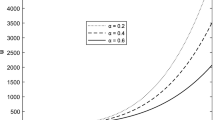Abstract
A supersymmetric extension of a two-phase fluid flow system is formulated. A superalgebra of Lie symmetries of the supersymmetric extension of this system is computed. The classification of the one-dimensional subalgebras of this superalgebra into 63 equivalence classes is performed. For some of the subalgebras, it is found that the invariants have a non-standard structure. For six selected subalgebras, the symmetry reduction method is used to find invariants, orbits of the subgroups and reduced systems. Through the solutions of the reduced systems, the most general solutions are expressed in terms of arbitrary functions of one or two fermionic and one bosonic variables.
Similar content being viewed by others
References
Courant, R., Hilbert, D.: Methods of Mathematical Physics, vol. 2. Interscience, New York (1962)
Mises, R.: Mathematical Theory of Compressible Fluid Flow. Academic Press, New York (1958)
Lighthill, H.: Hyperbolic Equations and Waves. Springer, New York (1968)
Whitham, G.B.: Linear and Nonlinear Waves. Wiley, New York (1974)
Lamb, H.: Hydrodynamics. Cambridge University Press, Cambridge (1993)
Jeffrey, A.: Quasilinear Hyperbolic Systems and Waves. Pitman, San Francisco (1976)
Rozdestvenskii, B., Janenko, N.: Systems of Quasilinear Equations and Their Applications to Gas Dynamics. Translation Math. Monographs, vol. 55. AMS, Providence, RI (1983)
Godunov, S.K.: Mathematical Physics Equations. Nauka, Moscow (1979). (in Russian)
Jackiw, R.: A Particle Theorist’s Lectures on Supersymmetric Non-abelian Fluid Mechanics and d-Branes. Springer, New York (2002)
Majda, A.: Compressible Fluid Flow and Systems of Conservation Laws in Several Space Variables. Springer, New York (1984)
Peradzynski, Z.: Advances in nonlinear waves. In: Debnath, L. (ed.) Research Notes in Math, vol. 111. Pitman, Boston (1985)
Ovsiannikov, L.V.: Group Analysis of Differential Equations. Academic Press, New York (1982)
Zakharov, V.: Nonlinear Waves and Weak Turbulence. Advances of Modern Mathematics Translation, Series 2. AMS, Providence (1997)
Riemann, B.: Versuch Einer Allgemeinen Auffassung der Integration und Differentiation. Teubner, Leipzig, (1876); ibid. Dover, New York (1953), pp. 331–344
Riemann, B.: Über die Fortpflanzung Ebener Luftwellen von Endlicher Schwingungsweite. Teubner, Leipzig, (1876); ibid. Dover, New York (1953), pp. 145–164
Poisson, S.D.: Mémoire sur la théorie du son. Journal de l’École Polytechnique, \(14^{\text{i}\acute{\text{ e }}\text{ me }}\) cahier, 7, Paris, pp. 319–392 (1808)
Courant, R., Friedrichs, K.O.: Supersonic Flow and Shock Waves. Interscience, New York (1948)
Hugoniot, H.: J. Ec. Polytech. (Paris) 1, 57–79 (1887)
Opanasenko, S., Bihlo, A., Popovych, R.O., Sergeyev, A.: Generalized symmetries, conservation laws and Hamiltonian structures of an isothermal no-slip drift flux model. Phys. D 411, 132546 (2020)
Opanasenko, S., Bihlo, A., Popovych, R.O., Sergeyev, A.: Extended symmetry analysis of isothermal no-slip drift flux model. Phys. D 402, 132188 (2020)
Panov, A.V.: Invariant solutions and submodels in two-phase fluid mechanics generated by 3-dimensional subalgebras. Barochronous flows. Int. J. Non-Linear Mech. 116, 140–146 (2019)
John, F.: Nonlinear wave equations, formation of singularities, university lecture series 2. AMS, Providence (1990)
John, F.: Formulation of singularities in one-dimensional nonlinear wave propagation. Commun. Pure Appl. Math. 27, 377–394 (1974)
Cornwell, J.F.: Group Theory in Physics, vol. 3. Academic Press, London (1989)
DeWitt, B.: Supermanifolds. Cambridge University Press, Cambridge (1984)
Rogers, A.: A global theory of supermanifolds. J. Math. Phys. 21, 1352–1365 (1980)
Rogers, A.: Supermanifolds: Theory and Applications. World Scientific, London (2007)
Manin, Y.I., Radul, A.O.: A supersymmetric extension of the Kadomtsev-Petviashvili hierarchy. Commun. Math. Phys. 98, 65 (1985)
Fatyga, B.W., Kostelecky, V.A., Truax, D.R.: Grassmann-valued fluid dynamics. J. Math. Phys. 30, 1464–1472 (1989)
Grundland, A.M., Hariton, A.J.: Supersymmetric version of the Euler system and its invariant solutions. Symmetry 5, 253–270 (2013)
Grundland, A.M., Hariton, A.J.: Supersymmetric formulation of polytropic gas dynamics and its invariant solutions. J. Math. Phys. 52, 043501 (2011)
Grundland, A.M., Hariton, A.J.: Supersymmetric version of a hydrodynamic system in Riemann invariants and its solutions. J. Math. Phys. 49, 043502 (2008)
Grundland, A.M., Hariton, A.J.: Supersymmetric version of a Gaussian irrotational compressible fluid flow. J. Phys. A Math. Theor. 40, 15113–15129 (2007)
Freed, D.S.: Five Lectures on Supersymmetry. AMS, Providence (1999)
Varadarajan, V.S.: Reflections on Quanta. Symmetries and Supersymmetries. Springer, New York (2011)
Olver, P.J.: Applications of Lie Groups to Differential Equations. Springer, New York (1986)
Sidorov, A.F., Shapeev, V., Janenko, N.: Method of Differential Constraints Applied to Gas Dynamics. Nauka, Moscow (1984). (in Russian)
Winternitz, P.: Lie groups and solutions of nonlinear partial differential equations. In: Ibort, L.A., Rodriguez, M.A. (eds.) Integrable Systems, Quantum Groups and Quantum Field Theories, p. 429. Kluwer, Dordrecht (1993)
Goursat, E.: Sur les substitutions orthogonales et les divisions régulières de l’espace. Ann. Sci. Ec. Norm. Sup. 6(3), 9–102 (1880)
Clarkson, P.A., Winternitz, P.: Symmetry reduction and exact solutions of nonlinear partial differential equations. In: Conte, R. (ed.) The Painlevé Property, One Century Later, p. 597. Springer, New York (1999)
Acknowledgements
Both authors thank the Mathematical Physics Laboratory of the Centre de Recherches Mathématiques, Université de Montréal for its support during the writing of this paper.
Author information
Authors and Affiliations
Corresponding author
Ethics declarations
Conflict of interest
The authors declare that they have no conflict of interest.
Additional information
Publisher's Note
Springer Nature remains neutral with regard to jurisdictional claims in published maps and institutional affiliations.
This research was supported by a research grant from NSERC of Canada.
Appendix
Appendix
The following list constitutes the classification of the one-dimensional subalgebras of the Lie symmetry superalgebra associated with the supersymmetric system (21), (22) and (23) into conjugacy classes under the action of the associated Lie group. Here \(\varepsilon =\pm 1\), the parameters a and b are non-zero bosonic constants, and \({\underline{\mu }}\) and \({\underline{\nu }}\) are non-zero fermionic constants.
Rights and permissions
About this article
Cite this article
Grundland, A.M., Hariton, A.J. Invariant solutions of the supersymmetric version of a two-phase fluid flow system. Ricerche mat 71, 757–775 (2022). https://doi.org/10.1007/s11587-021-00569-1
Received:
Revised:
Accepted:
Published:
Issue Date:
DOI: https://doi.org/10.1007/s11587-021-00569-1



